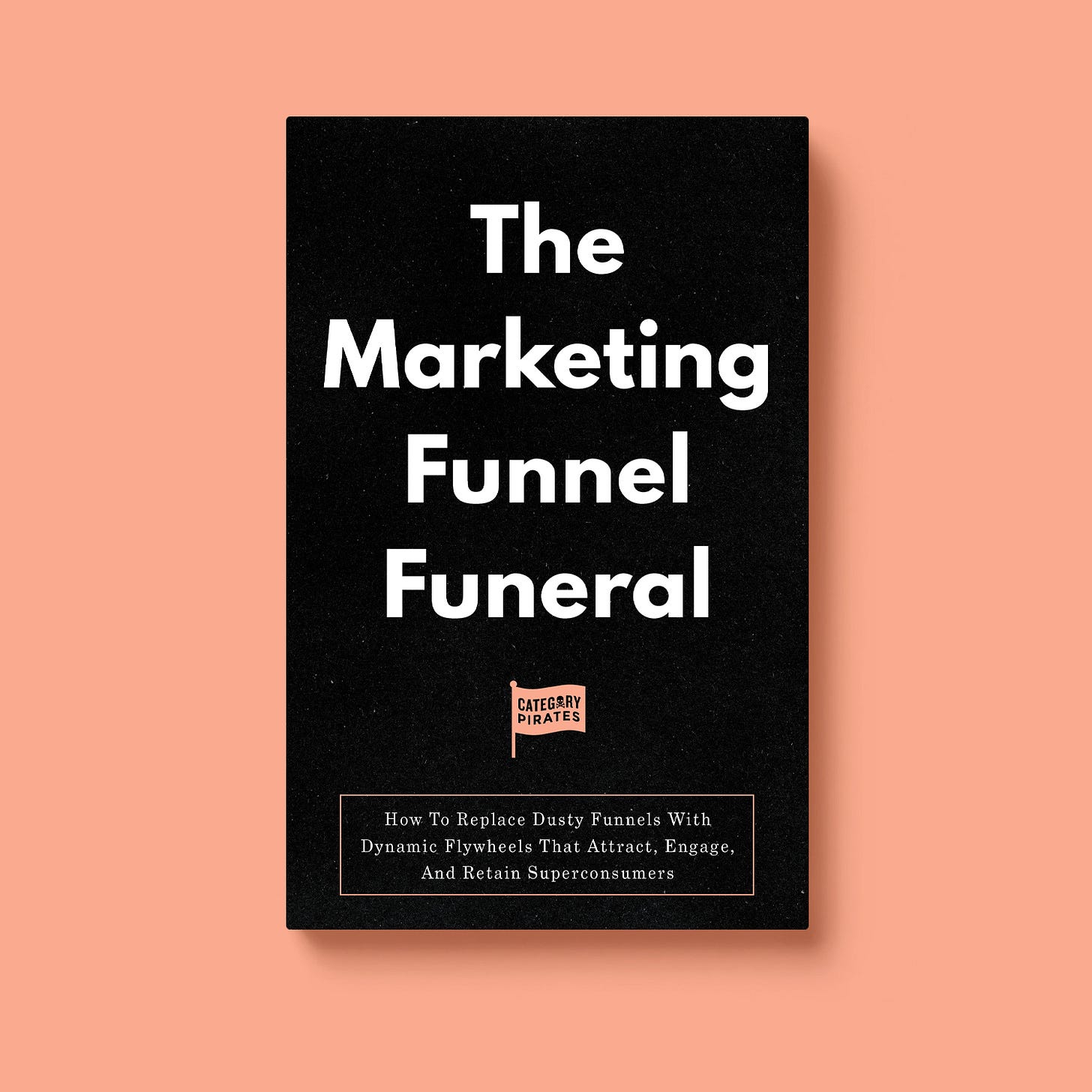The Marketing Funnel Funeral: How To Replace Dusty Funnels With Dynamic Flywheels That Attract, Engage, And Retain Superconsumers
Flywheels put the customer front and center, captivating them with valuable content, experiences, data, and community.
Arrrrr! 🏴☠️ Welcome to a 🔒 subscriber-only edition 🔒 of Category Pirates. Each week, we share radically different ideas to help you design new and different categories. For more: View the mini-book archive | Listen to a category design jam session | Dive into an audiobook | Enroll in the free Category Accelerator email course
Dear Friend, Subscriber, and Category Pirate,
In 2015, Sam Parr and John Havel decided to reject the premise of the news landscape.
They noticed that young professionals and entrepreneurs wanted a different type of content—news that cut through the noise, provided actionable insights, and sparked meaningful conversations.
So, they started a “news without the B.S.” newsletter.
It attracted tech-hungry Millennials, but not by using a traditional marketing funnel (paid advertising, lead generation, nurture campaigns, promotions, etc.).
Instead, Sam and John created a platform that revolved around community. From the beginning, they focused on collecting email addresses. (In fact, you couldn't preview the newsletter without sharing your email.) But your email was just your entrance ticket. After signing up for the newsletter, you soon received an invite to join its ambassador program.
The program felt like an exclusive club.
As an ambassador, you could easily start a conversation with other ambassadors—like-minded entrepreneurs, over-achievers, and super connectors—and your network immediately became ultra-valuable.
The program started to build momentum and attract more people to both the newsletter and the community. Why? Because it resonated with a new generation of ambitious Native Digitals looking for unconventional insights and a community to call their own.
Most importantly, it was self-sustaining.
It brought in new people through a compelling referral program.
As an ambassador, you could refer people and get rewarded for it. The more people you referred, the more perks you got. This included an invite to a private Facebook group, discounted tickets to the company’s annual conference, and plenty of schwag to show your loyalty to the program.
Of course, the program took time to grow.
"Communities take forever to build up," said Parr in an interview with Simon Owens. "It was a slow burn." But the community began to attract more and more people as ambassadors connected online and in person.
Eventually, it took off.
By the time HubSpot acquired The Hustle for an estimated $27 million, it had over 1.5 million subscribers.
The Hustle developed a strong sense of community among its readers. It encouraged conversations in comments, forums, and in-person events (which started a digital WOM wildfire). Most importantly, it created a space for Superconsumers to connect. And, in turn, this created a sense of belonging and loyalty among members.
In other words, it succeeded thanks to a self-revolving, velocity-increasing marketing flywheel.
The Hustle was not like a legacy media brand puking out content in a never-ending one-way stream of consciousness. Instead, it drove connections and conversations. It was not a thing you consumed. It was something you were a part of.
(Most Native Analog media businesses still do not understand this.)
And it worked because humans, more than (almost) anything else, want to experience being part of something greater than themselves.
Mercenary Marketers Capture Customers, Missionary Marketers Attract Customers
Marketing is fundamentally broken.
You already know the underlying reason why—we covered it in The Big Brand Lie mini-book. Brand marketing is something we do to customers. Category marketing is something we do for customers. That logic extends to all areas of marketing, especially the marketing you do to attract customers and create demand.
(Note: When most marketing people say “demand creation” they really mean capturing existing demand, instead of creating net new demand from nothing.)
For example, companies have forever wanted to put “brand value” on the balance sheet. But it’s impossible. Brand value doesn't show up on the balance sheet because brands don't own it. The brand’s network owns it.
Here’s another way to think about it:
Do Warren Buffett and Charlie Munger own Berkshire Hathaway?
Sure, they own some of it. But the real owners are those crazy 40,000+ people who show up at Berkshire’s annual “Woodstock” shareholder meetings. Without them, Berkshire wouldn’t be Berkshire. These people attend year after year, flying in from all over the world just for a three-day weekend in Omaha, Nebraska. Why? They go to see old friends who they met 25 years ago and build new relationships. They go to hear Buffett and Munger share stories. They go to participate in the event and enjoy the experience. And they go to tell themselves (and the world) that they’re part of this unique group of investors.
Said differently, they go because they’re devoted to the Berkshire community—not because they were pushed through some sort of marketing funnel.
They’re attracted (to be part of something). Not captured (to buy something).
Marketing Funnels Are For Capturing Customers, Marketing Flywheels Are For Attracting Customers
Funnels provide a linear path for companies to push consumers from awareness to consideration—and ultimately to purchase. Flywheels put the customer front and center, captivating them with valuable content and experiences that speak to their deepest desires.
The difference is causing an irreversible change in marketing.








